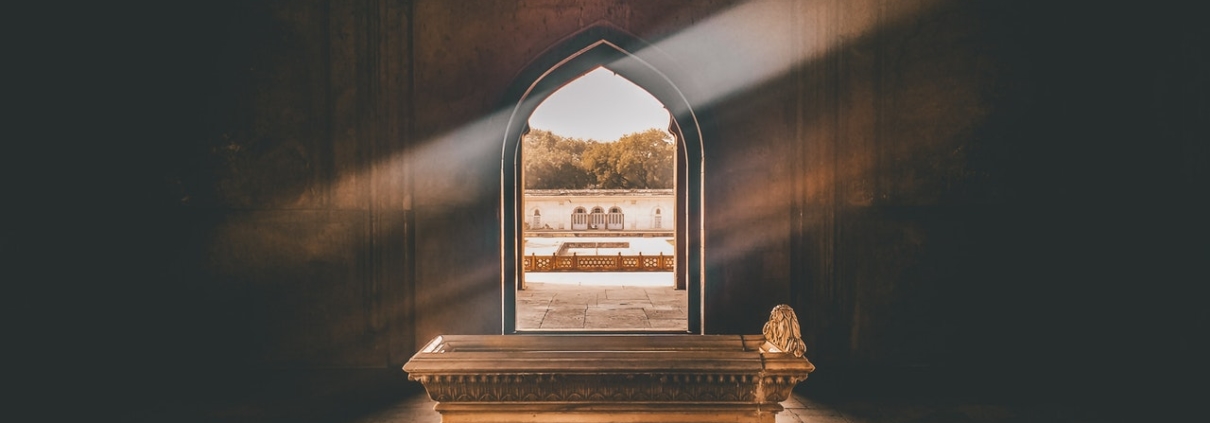Creating Ritual: Sacred Space
“[Sacred space] is an absolute necessity for anybody today. You must have a room, or a certain hour or so a day, where you don’t know what was in the newspapers that morning, you don’t know who your friends are, you don’t know what you owe anybody, you don’t know what anybody owes to you. This is a place where you can simply experience and bring forth what you are and what you might be. This is the place of creative incubation. At first you may find that nothing happens there. But if you have a sacred place and use it, something eventually will happen.” ~ Joseph Campbell
In my second article in a series on creating ritual, I want to discuss the practice of creating sacred space. Any type of ritual practice begins with the creation of sacred space, and there are many practices we can draw from in order to do this. I will discuss working with the physical space, creating sacred space internally, and the setting of sacred boundaries.
Creating Sacred Space Physically
I want to preface this section by letting you know that though I have been practicing yoga & meditation since the late ’90s, and yet I have never had a dedicated space for practice in my home. Meaning I have never had a room to myself. Yet I have claimed corners and sections of my home, either just for the time of my practice or more permanently by setting up an altar. Do not let a lack of space in your home be an obstacle to doing the practice. Sacred space for practice can be created anywhere, and for most of my life, it has been simply the space of my yoga mat or the space around my meditation cushion. Around this little island of intentionality that I would create would be children’s toys, restless pets, dusty floors, laundry to be folded etc, all the accouterments of daily life. And yet the space I set aside for practice became sacred because I made it so. Below are some simple things you can do to create sacred space in your home or for your practice.
Temporary Practice Space: I have often had to do the ritual of my yoga practices in my living room and so my sacred space exists only for the time of my practice. I would begin by sweeping the floor, laying out my mat, and then lighting a candle and some incense to set the mood. This would help me bring my practice into focus and allow me to ignore the reminders of mundane necessity around me. In other words, once I enter into this sacred space I commit to not being distracted by the dust balls I might see under the couch when in Down Dog. When my practice is done I put my mat & cushion aw ay in a basket kept in the corner of the living room (with my incense & candle), a reminder that I can create that space again when needed.
ay in a basket kept in the corner of the living room (with my incense & candle), a reminder that I can create that space again when needed.
This practice can be done in any space and if you are in a public place (like an airport or hotel room) and you cannot smudge or light incense, simply visualize an energetic boundary of intention around your mat or cushion.
Permanent Practice Space: If you are fortunate enough to have a permanent space in your home for practice, then you can make it sacred with a few simple practices. The first is to cleanse it, this can be both physical and energetic cleansing. It may include some dusting, some smudging, and some visualization. Then place within this space objects that will support your practices such as candles & incense, your meditation cushion or yoga mat, singing bowls or bells, and an altar space (which can be as simple or as elaborate as you like). You might also keep a journal in this space for noting down your reflections, or books that inspire your personal practices. If you create an intentional altar space it is recommended that along with the images that tie you to your lineage or tradition of practice, you also include the elements in some form. Water, fire, earth, & wind are used in most traditional spiritual traditions, you might also include space or spirit depending on which system you work with. My own altar includes a chalice made of clay to hold water, incense for air, a candle for fire, and earth treasures gathered over the years on my long hikes in the woods. I also try to have flowers as much as possible. The key thing here is to make this a special place that you keep clean & sacred, free from everyday objects, a place that will absorb & amplify the work of your practices and provide a blessing space for you to return to.
My own permanent altar is on a dresser in my bedroom, I know others who keep theirs on a bookshelf or in a cupboard they open up for practice time. It may just be a small corner or a closet, but make it yours!
Creating Sacred Space Internally
The next and most important step in the ritual of our practice is to create a sense of sacred space internally. This means clearing space in the mind and heart for the work we are going to do, and generally includes practices of centering, but may also include invocation, mantra or prayer. This is important because we often need to make a conscious shift from the frame of reference with which we move through our everyday tasks (planning, organizing, & doing mind), into the more sensitive and curious state of consciousness (listening, feeling, & receiving mind) that so supports our practices. Again these practices of creating sacred space internally can be as simple or as elaborate as you like. My own are organic and somewhat changing, influenced & inspired by the wisdom traditions I have studied, and also of my own creation. They generally include a short practice of invocation in which I chant mantras that bring me into resonance with the energy currents & blessing forces I have chosen to be in relationship with, a short statement of intent (said aloud or in my own mind), and a very organic practice of personal prayer, followed by a few moments of sitting quietly. In this quiet sitting I am “drawing in the threads” of my awareness, moving my attention away from task-oriented thinking, and allowing my inner senses to expand. This takes longer some days, depending on how much has been going on in my mind & heart, but I wait till I feel that sense of having subtly shifted into a more spacious internal experience before moving into the body of my practices for the day.
What makes space sacred? The level of attention and intention we bring to it, it’s as simple as that. You can create sacred space internally no matter where you are, and no matter how much is going on. Remember that.
Sacred Boundaries
In a fast-paced world where we are all increasingly accessible, it has become necessary to set some sacred boundaries in order to preserve a sense of having spaces within our daily lives that are inviolable. I am not referring to physical space here, but rather having times of the day where we cannot be reached by phones or emails, text messages or other technology. Times of day where we can slip into a more natural rhythm, become aware of what is actually happening in the space around us and connect to our present moment fully. When I was younger I spent a few years living without electricity. I had no telephone or computer, no television, and certainly no cell phone (as this was before everyone had one!). These years were foundational in teaching me how to listen to and respond to my own body’s needs & messages, and to really hear what my heart had to say. Most of us cannot “drop out” and go live in the woods for a few years to re-connect to ourselves, and yet we can create some of this sacred space every day with some simple & loving discipline. Of particular importance in creating sacred boundaries in your everyday routine is to consider what you value and which aspects of your daily life you want to keep sacred. Below are some ways that I am currently practicing creating sacred space through the making of boundaries around technology
- How I start and end my day. Phones & computers go off at least 1 hour before bedtime and are not turned on again until after I have done my morning meditation.
- Walks with my dog and hikes with my family. I used to always take my phone as I use it for a camera, leaving it behind has helped me to unplug more fully in those moments. You can always put it on “airplane mode” too, or simply turn off all notifications and still take photos!
- Meal times! Whether I am eating my lunch alone at my kitchen table (which is also my office) or having dinner with my family, these times are for connecting and receiving and are free from technology.
- In my bedroom. Try to keep your bedroom technology free and notice how much better you sleep, how much more relaxed you feel upon waking, and how much more of a peaceful refuge your bedroom becomes.
This article is far from exhaustive on the topic of creating sacred space, but I hope it has offered some inspiration and insight. Remember this is not a hard science and what matters is that you make the art of Creating Ritual in your life alive for you!













